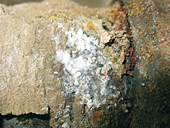Special Measurements
Inerting of Grinding Mills
In grinding mills for combustible materials such as hard coal, lignite, wood or other biomass an explosive atmosphere can can occur in case of malfunction or even in normal operation. In these cases, the grinding mill must be rendered inert. The inertization is usually carried out by the injection of inert gases such as flue gas, water vapor, CO2 or nitrogen.
In many cases, however, leakages or sealing air provide for an indefinite supply of oxygen during inerting. By means of an oxygen measurement, it can be quickly demonstrated whether an inerting is achieved or whether further measures have to be provided by the operator. heat and power engineering carries out the necessary oxygen and air measurements and advises you on plant optimization.
Aging of Materials
An analysis of corrosion damage in incinerators includes the determination of corrosion mechanisms and rates. This requires a tempered aging of material samples in the prevailing flue gas atmosphere.
Corrosion Probe

The life of evaporator and superheater pipes has a significant impact on the economics of waste incineration plants or pulverized fuel plants. A large part of all power plant failures is due to pipe damage in this area. The testing of novel materials or the addition of additives in flue gas is costly, lengthy and associated with high risks of outages. Process and plant technology changes can only be implemented with great effort.

For these reasons, heat and power engineering developed a temperature-controlled corrosion probe for the temporary aging of tubular specimens in close collaboration with the Institute of Combustion and Power Plant Technology (IFK) at the University of Stuttgart.
In the probe head, pipe samples of various test materials can be clamped at the same time and stored up to 1.5 m deep in the boiler. The specially developed air cooling ensures an extremely homogeneous temperature distribution both axially and radially.

X-ray analysis
(EDX)

(BSE)
A subsequent material analysis allows a comparative determination of the material quality in the corresponding flue gas atmosphere. The corrosion rate is determined optically with the aid of a scanning electron microscope. For background analysis, backscattered electron images and EDX/ WDX X-ray analyzes are available. For traceability of the results, the operating parameters of the boiler are also evaluated.
Further measurements
heat and power engineering also carries out gas analyzes or refractory pyrometry for the purpose of operational optimization. If necessary, we also design special probes, e.g. for very large ducts or for cooling the meter.
Ask us.
Deutsch


